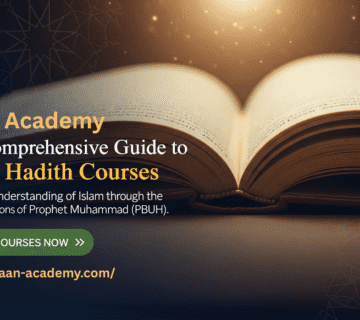A Quranic Arabic course is an educational program specifically designed to teach students the Arabic language as it is used in the Holy Quran. Unlike modern standard Arabic (MSA) or colloquial dialects, Quranic Arabic focuses on the vocabulary, grammar, and sentence structures most prevalent in the Quran, allowing learners to directly understand and appreciate the divine text.
Why Learn Quranic Arabic? (Benefits)
Learning Quranic Arabic offers profound benefits for Muslims and anyone interested in deeply engaging with the Quran:
- Direct Understanding of the Quran: This is the primary and most significant benefit. Translations, while helpful, can never fully capture the depth, nuances, and eloquence of the original Arabic. Learning the language allows you to grasp the exact meanings, rhetorical devices, and subtleties intended by Allah.
- Deeper Spiritual Connection (Khushu’ in Salah): Understanding the words you recite during daily prayers (Salah) transforms it from a routine act into a deeply meaningful spiritual experience. It enhances concentration (khushu’), devotion, and allows for a more profound connection with Allah.
- Appreciation of Quranic Miracles: The Quran is known for its linguistic and rhetorical miracles. Learning its language allows you to appreciate its poetic beauty, unique expressions, and the precise word choice that often carries layers of meaning.
- Access to Tafsir and Islamic Sciences: Quranic Arabic is the key to unlocking classical Islamic literature, including authentic Tafsir (exegesis), Hadith collections, Fiqh (jurisprudence), and other scholarly works, which are primarily in Arabic.
- Improved Recitation and Tajweed: Understanding the meaning of the words helps in proper pronunciation and application of Tajweed rules (rules of Quranic recitation), leading to more accurate and beautiful recitation.
- Intellectual Growth: Engaging with the rich and complex structure of Quranic Arabic stimulates the brain, enhancing memory, problem-solving skills, and analytical thinking.
- Connection to Islamic Heritage and Unity: It connects you directly with the foundational language of Islam, fostering a stronger bond with the rich cultural and historical context in which the Quran was revealed. It also serves as a unifying factor among Muslims worldwide.
- Independent Study: It empowers you to independently examine verses, critically assess different interpretations, and gain a more informed understanding of Islam.
Typical Quranic Arabic Course Program and Lessons
Online Quranic Arabic courses are usually structured in levels (Beginner, Intermediate, Advanced) and progressively build on foundational knowledge.
I. Foundational Level (Beginner)
- Lesson 1: The Arabic Alphabet and Basic Pronunciation (Noorani Qaida/Qaida Norania)
- Learning each letter (shapes, forms in different positions).
- Correct articulation points (Makharij al-Huruf) for each letter.
- Short and long vowels (Harakat and Madd letters).
- Basic Tajweed rules (e.g., Sukoon, Shaddah, Tanween).
- Lesson 2: Basic Vocabulary from the Quran
- Introduction to frequently occurring words in the Quran (e.g., Allah, Rahman, Raheem, Kitab, Yaum).
- Focus on words that make up a significant percentage of the Quran’s vocabulary.
- Lesson 3: Introduction to Nouns (Ism)
- Recognition of nouns (common vs. proper, definite vs. indefinite).
- Gender (masculine, feminine) and number (singular, dual, plural).
- Basic cases (Nominative, Accusative, Genitive) and their endings.
- Lesson 4: Introduction to Verbs (Fi’l)
- Past tense (Madhi) and Present/Future tense (Mudari’).
- Basic verb conjugations for common pronouns.
- Lesson 5: Basic Particles/Prepositions (Harf)
- Common prepositions (e.g., fi, min, ila, ala, bi, li).
- Conjunctions (e.g., wa, fa, thumma).
- Lesson 6: Simple Sentence Structures
- Nominal sentences (Jumla Ismiyyah).
- Verbal sentences (Jumla Fi’liyyah).
- Simple phrases (e.g., possessive phrase, descriptive phrase).
- Lesson 7: Practice with Short Quranic Verses
- Applying learned vocabulary and grammar to short surahs (e.g., Surah Al-Fatihah, short surahs from Juz Amma).
II. Intermediate Level
- Lesson 8: Deeper Dive into Nouns
- Broken plurals, sound plurals.
- Advanced noun types (e.g., Ism al-Faa’il, Ism al-Maf’ool – active/passive participles).
- Advanced possessive constructions.
- Lesson 9: Advanced Verb Morphology (Sarfa)
- Different verb forms and their derived meanings (e.g., Form II, Form III verbs).
- Weak verbs, hollow verbs, hamzated verbs.
- Lesson 10: Quranic Grammar (Nahw)
- Detailed study of case endings (I’rab) and their significance.
- Conditional sentences, relative clauses.
- Understanding different types of pronouns (detached and attached).
- Lesson 11: Rhetoric and Balagha (Eloquence)
- Introduction to basic rhetorical devices used in the Quran.
- Understanding emphasis, repetition, and stylistic choices.
- Lesson 12: Expanded Quranic Vocabulary
- Focus on less frequent but important vocabulary.
- Root word analysis and deriving meanings.
- Lesson 13: Analysis of Medium-Length Quranic Verses
- Applying grammar and vocabulary to verses from various surahs.
- Beginning to use a Quranic dictionary (Mu’jam).
III. Advanced Level
- Lesson 14: In-depth Quranic Grammar and Syntax
- Complex sentence structures, exceptions, and intricate grammatical rules.
- Advanced topics in I’rab and the nuances of particles.
- Lesson 15: Advanced Morphology and Derivations
- Mastering all verb forms and their intricate conjugations.
- Deeper understanding of noun and verb derivations.
- Lesson 16: Balagha and Quranic Style
- Advanced study of Quranic rhetoric, metaphors, similes, and literary devices.
- Appreciating the inimitable style of the Quran.
- Lesson 17: Tafseer Principles (Usul al-Tafseer)
- Introduction to the methodology of Quranic exegesis.
- Understanding different types of Tafseer.
- Lesson 18: In-depth Analysis of Selected Surahs/Verses
- Detailed grammatical and contextual analysis of specific sections of the Quran.
- Connecting linguistic understanding to deeper meanings and lessons.
- Lesson 19: Introduction to Hadith Arabic
- Understanding common linguistic patterns in Hadith literature, which share much with Quranic Arabic.
- Lesson 20: Independent Quranic Study Skills
Common Online Course Features:
- Qualified Tutors: Often native Arabic speakers, highly knowledgeable in Quranic Arabic, Tajweed, and Islamic sciences.
- One-on-One or Group Classes: Many platforms offer personalized attention.
- Interactive Sessions: Live classes, discussion forums, Q&A.
- Multimedia Resources: Videos, audio files, interactive exercises, flashcards.
- Downloadable Materials: Notes, PDFs of classic Arabic texts (like Madinah Arabic books or Lisan al-Quran series).
- Progress Tracking: Quizzes, assignments, and regular assessments.
- Certificates of Completion.
- Flexible Scheduling: To accommodate students worldwide.
Quranic Arabic course At Quran Academy
When you’re looking for a “Quranic Arabic course” specifically from a “Quran Academy” online, it’s important to know that many online Islamic educational platforms use variations of “Quran Academy” in their names. They often provide a range of courses, with Quranic Arabic being a key offering.
Here’s a synthesis of what you can typically expect from a Quranic Arabic course offered by such academies, based on the common features and curricula advertised by various “Quran Academy” type websites:
Overall Approach and Goal:
The primary goal of a Quranic Arabic course from an online Quran Academy is to enable non-Arabic speakers to understand the Holy Quran directly, without relying solely on translations. They aim to foster a deeper connection with the divine text and enhance the spiritual experience of recitation and prayer.
Key Features You’ll Likely Find:
-
Focus on Quran-Specific Arabic:
- While they may cover general Arabic grammar, the emphasis is heavily on the vocabulary, grammar patterns, and sentence structures most frequently found in the Quran.
- Often, they’ll prioritize high-frequency Quranic words and then build up from there.
-
Structured Levels:
- Courses are almost always divided into beginner, intermediate, and advanced levels.
- Beginner Level: Typically starts with the Arabic alphabet (often using a system like Noorani Qaida for correct pronunciation), basic vocabulary, simple noun and verb forms, and foundational sentence structures. The goal is often to enable understanding of short surahs (e.g., Juz Amma).
- Intermediate Level: Delves deeper into grammar (Nahw) and morphology (Sarf), covering more verb forms, complex noun types, and various grammatical cases (I’rab). Students start analyzing longer Quranic verses.
- Advanced Level: Focuses on intricate grammatical structures, advanced rhetoric (Balagha), and detailed analysis of Quranic passages. The aim is often to enable students to engage with classical Tafsir (exegesis) works in Arabic.
-
Qualified and Native Instructors:
- Many academies pride themselves on having native Arabic-speaking teachers, often graduates from prestigious Islamic universities like Al-Azhar in Egypt or universities in Madinah.
- They are typically experienced in teaching Arabic to non-native speakers.
-
Flexible Learning Options:
- One-on-One Classes: Very common, offering personalized attention, customized pacing, and direct interaction. This is often highlighted as a major benefit.
- Group Classes: Some academies offer small group settings for a collaborative learning experience.
- Self-Paced Learning: Many provide access to pre-recorded video lectures and downloadable materials, allowing students to learn at their own convenience.
- Flexible Scheduling: They often operate 24/7 or have wide availability to accommodate students in different time zones.
-
Interactive Learning Environment:
- Live video conferencing tools (Zoom, Skype) are standard.
- Digital whiteboards, screen sharing, and interactive exercises.
- Online quizzes and assignments to test comprehension.
- Discussion forums or chat groups for student and teacher interaction.
-
Comprehensive Curriculum Content (often integrated):
- Arabic Alphabet & Tajweed: Even in Quranic Arabic courses, there’s usually a strong component of proper Arabic letter pronunciation and foundational Tajweed rules, as correct recitation is intertwined with understanding.
- Vocabulary Building: Systematic introduction of high-frequency Quranic words and their root meanings.
- Grammar (Nahw): Rules for how words combine to form sentences, including noun cases, verb conjugations, and sentence types.
- Morphology (Sarf): Understanding how words are derived from root letters and how changes in form affect meaning.
- Contextual Understanding: Some courses will integrate basic Tafsir to help students understand the context and broader meaning of verses as they learn the language.
-
Support and Resources:
- Downloadable PDF notes, worksheets, and sometimes digital copies of popular Quranic Arabic textbooks (e.g., Madinah Arabic books).
- Progress reports and certificates of completion upon finishing levels.
- Often, a free trial class is offered to allow prospective students to experience the teaching style.
To find the best “Quran Academy” for your Quranic Arabic needs, it’s recommended to:
- Visit specific websites: Visit Quran Academy websites from here.
- Check their “Courses” or “Curriculum” sections: Look for “Quranic Arabic,” “Classical Arabic,” or “Arabic for Quran Understanding.”
- Take a trial class: This is the best way to assess the teaching methodology, the instructor’s style, and the online platform’s usability before committing.





Hi there! I just wanted to ask if you ever have any problems with hackers? My last blog (wordpress) was hacked and I ended up losing a few months of hard work due to no data backup. Do you have any solutions to prevent hackers?
Hi! Quick question that’s totally off topic. Do you know how to make your site mobile friendly?
My site looks weird when viewing from my iphone.
I’m trying to find a template or plugin that might be able to correct this problem.
If you have any suggestions, please share. Thank you!
Once I originally commented I clicked the -Notify me when new feedback are added- checkbox and now every time a remark is added I get 4 emails with the same comment. Is there any approach you’ll be able to remove me from that service? Thanks!